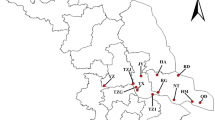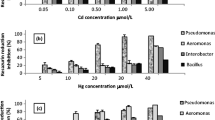Abstract
Synthetic wastewater with bisphenol A (BPA) concentrations of 7.5, 20, and 40 mg/L was treated with activated sludge sequential batch reactors (SBRs). The sludge acute toxicity indicated by the inhibitory ratio to luminous bacteria T3 was evaluated. The influent COD was controlled at approximately 300 mg/L, and aerobic conditions were maintained in the SBR. It was found that the process of BPA biodegradation, as opposed to BPA adsorption, contributed to the formation of sludge toxicity; there was a positive relationship between sludge toxicity and influent BPA concentration, and the toxicity centralized in intracellular regions and the intersection of extracellular polymeric substances (EPS) in sludge flocs. Since the BPA biodegradation process dedicated to sludge toxicity, the influence of key operational parameters such as sludge retention time (SRT) and hydraulic retention time (HRT) on sludge toxicity were investigated. It was founded that sludge toxicity decreased significantly when SRT and HRT were shortened from 20 to 10 days and 12 to 8 h, respectively. The results of Pearson correlation analysis indicated that the Shannon index H of the bacterial community correlated significantly to sludge toxicity. The results from both similarity analysis and UPGMA indicated that influent quality characteristic contributes much more to bacterial community than operation parameters, and then leads to difference between blank and control sludge toxicity.





Similar content being viewed by others
References
Abad E, Martínez K, Planas C, Palacios O, Caixach J, Rivera J (2005) Priority organic pollutant assessment of sludges for agricultural purposes. Chemosphere 61:1358–1369
Agnés YR, Rajeshwar DT, Réjean S (2001) Assessment of toxicity reduction after metal removal in bioleached sewage sludge. Water Res 35(6):1415–1424
Alvarenga P, Palma P, Gonçalves AP, Fernandes RM, Cunha-Queda AC, Vallini E, Duarte G (2007) Evaluation of chemical and ecotoxicological characteristics of biodegradable organic residues for application to agricultural land. Environ Int 33:505–513
Andrés P, Mateos E, Tarrasón D, Cabrera C, Figuerola B (2011) Effects of digested, composted, and thermally dried sewage sludge on soil microbiota and mesofauna. Appl Soil Ecol 48:236–242
Andrew Crain D, Eriksen M, Iguchi T, Jobling S, Laufer H, LeBlanc Gerald A, Guillette J, Louis J (2007) An ecological assessment of bisphenol-A: evidence from comparative biology. Reprod Toxicol 24:225–239
Bottm CB, Love NG (2001) The immunochemical detection of stress proteins in activated sludge exposed to toxic chemicals. Water Res 35(1):91–100
Bright DA, Healey N (2003) Contaminant risks from biosolids land application: contemporary organic contaminant levels in digested sewage sludge from five treatment plants in Greater Vancouver, British Columbia. Environ Pollut 126:39–49
Cai QY, Mo CH, Wu QT, Zeng QY, Katsoyiannis A (2007) Occurrence of organic contaminants in sewage sludge from eleven wastewater treatment plants. China Chemosphere 68:1751–1762
Can A, Semiz O, Cinar O (2005) Bisphenol A induces cell cycle delay and alters centrosome and spindle microtubular organization in oocytes during meiosis. Mol Hum Reprod 11(6):389–396
Cantarero S, Prieto CA, López I (2012) Occurrence of high-tonnage anionic surfactants in Spanish sewage sludge. J Environ Manag 95:S149–S153
Cao XQ, Chen J, Tang C, Li OY (2005) Characteristic change and analysis of excess sludge after ultrasonic treatment. Environ Eng 23(5):84–86
Chen J, Huang X, Li S, Xiao Y (2008) Removal of bisphenol A in a membrane bioreactor. J Tsinghua Univ (Sci Technol) 48(6):999–1003, Chinese
Clarke BO, Smith SR (2011) Review of ‘emerging’ organic contaminants in biosolids and assessment of international research priorities for the agricultural use of biosolids. Environ Intl 37:226–247
Clarke B, Porter N, Symons R, Blackbeard J, Ades P, Marriott P (2008a) Dioxin-like compounds in Australian sewage sludge—review and national survey. Chemosphere 72:1215–1228
Clarke B, Porter N, Symons R, Marriott P, Ades P, Stevenson G, Blackbeard J (2008b) Polybrominated diphenyl ethers and polybrominated biphenyls in Australian sewage sludge. Chemosphere 73:980–989
Craig DR, Brown E, Craft JA (2003) Effects of sewage effluent and ethynyl oestradiol upon molecular markers of oestrogenic exposure, maturation and reproductive success in the sand goby. Aquat Toxicol 62(2):119–134
Cremonesi L, Fripo S, Ferrari M, Righetti PG, Gelfi C (1997) Double-gradient DGGE for optimized detection of DNA point mutations. Biotech 22:326–330
Dai J, Xu M, Chen J, Yang X, Ke Z (2007) PCDD/F, PAH and heavy metals in the sewage sludge from six wastewater treatment plants in Beijing. China Chemosphere 66:353–361
Deng NS, Wu F (2004) Endocrine disrupting chemicals in the environment. Chemical Industry Press (CIP), Beijing, China, 1-63, 209-214. (Chinese)
Frølund B, Palmgren R, Keiding K, Nielsen PH (1996) Extraction of extracellular polymers from activated sludge using a cation exchange resin. Water Res 30(8):1749–1758
Gallardo F, Cea M, Tortella GR, Diez MC (2012) Effect of pulp mill sludge on soil characteristics, microbial community and vegetal production of Lolium Perenne. J Environ Manag 95:S193–S198
Gao JF, Guo JQ, Chen RN, Su K (2008) Comparison of the efficiency of five extracellular polymeric substances (EPS) extraction methods using three dimensional excitation and emission matrix (EEM) fluorescence spectroscopy together with chemical analysis. Environ Chem 5:662–668
Gomez-Rico MF, Font R, Vera J, Fuentes D, Disante K, Cortina J (2008) Degradation of organic pollutants in Mediterranean forest soils amended with sewage sludge. Chemosphere 71:2129–2138
González MM, Martín J, Santos JL, Aparicio I, Alonso E (2010) Occurrence and risk assessment of nonylphenol and nonylphenol ethoxylates in sewage sludge from different conventional treatment processes. Sci Total Environ 408:563–570
Hamdi H, Manusadžianas L, Aoyama I, Jedidi N (2006) Effects of anthracene, pyrene and benzo[a]pyrene spiking and sewage sludge compost amendment on soil ecotoxicity during a bioremediation process. Chemosphere 65:1153–1162
Harrison EZ, Oakes SR, Hysell M, Hay A (2006) Organic chemicals in sewage sludges. Sci Total Environ 367:481–497
Hua L, Wu WX, Liu YX, Tientchen CM, Chen YX (2008) Heavy metals and PAHs in sewage sludge from twelve wastewater treatment plants in Zhejiang province. Biomed Environ Sci 21:345–352
IKE M (1999) Biodegradation of bisphenol A in the aquatic environment. Water Sci Technol 42(7–8):31–38
Lee SM, Koo BW, Choi JW, Choi DH, An BS, Jeung EB, Choi IG (2005) Degradation of bisphenol A by white rot fungi, Stereum hirsutum and Heterobasidium insulare, and reduction of its estrogenic activity. Biol Pharm Bull 28:201–207
Leung HW, Minh TB, Murphy MB, Lam JCW, So MK, Martin M, Lam PKS, Richardson BJ (2012) Distribution, fate and risk assessment of antibiotics in sewage treatment plants in Hong Kong, South China. Environ Int 42:1–9
Li XL, Wang ZY, Liu HL, Yu HX (2012) Quantitative structure-activity relationship for prediction of the toxicity of phenols on Photobacterium phosphoreum. Bull Environ Contam Toxicol 89:27–31
Majewsky M, Gallé T, Yargeau V, Fischer K (2011) Active heterotrophic biomass and sludge retention time (SRT) as determining factors for biodegradation kinetics of pharmaceuticals in activated sludge. Bioresour Technol 102:7415–7421
Mantis I, Voutsa D, Samara C (2005) Assessment of the environmental hazard from municipal and industrial wastewater treatment sludge by employing chemical and biological methods. Ecotox icol Environ Safe 62:397–407
Mohapatra DP, Brar SK, Tyagi RD, Surampalli RY (2010) Physico-chemical pre-treatment and biotransformation of wastewater and wastewater sludge-fate of bisphenol A. Chemosphere 78:923–941
Ricco G, Concetta TM, Ramadori R, Laera G (2004) Toxicity assessment of common xenobiotic compounds on municipal activated sludge: comparison between respirometry and Microtox. Water Res 38:2103–2110
Senesi N, Plaza C, Brunetti G, Polo A (2007) A comparative survey of recent results on humic-like fractions in organic amendments and effects on native soil humic substances. Soil Biol Biochem 39:1244–1262
Shannon CE, Weaver W (1949) The mathematical theory of communication. University of Illinois Press, Urbana IL
Shannon CE, Weaver W (1963) The mathematical theory of communication. University of Illinois Press, Urbana IL
Shen RY, Luo YM, Feng S, Zhang GY, Wu LH, Li ZG, Teng Y, Christie P (2009) Benzo[a]pyrene and phenanthrene in municipal sludge from the Yangtze River Delta, China. Pedosphere 19(4):523–531
Singh RP, Agrawal M (2008) Potential benefits and risks of land application of sewage sludge. Waste Manag 28:347–358
Spivack J, Leib TK, Lobos JH (1994) Novel pathway for bacterial metabolism of bisphenol A. Rearrangements and stilbene cleavage in bisphenol A. J Biol Chem 269:7323–7329
Sponza DT, Gok O (2011) Effects of sludge retention time (SRT) and biosurfactant on the removal of polyaromatic compounds and toxicity. J Hazard Mater 197:404–416
Wang ZP, Zang T (2010) Characterization of soluble microbial products (SMP) under stressful conditions. Water Res 44(18):5499–5509
Wang X, Zhao X (2007) Study on discharge and degeneration of environmental hormone biophenol A. Environ Sci Surv 26(1):17–20, Chinese
Wang XR, Jin YY, Du X, Nie YF (2007) Process and mechanism of indirect thermal drying of sewage sludge. J Chem Ind Eng 58(9):2211–2215
Winkler MKH, Robbert K, Khunjar WO, De Bruin B, Van Loosdrecht MCM (2012) Evaluating the solid retention time of bacteria in flocculent and granular sludge. Water Res 46:4973–4980
Xing L, Liu H, Giesy JP, Yu H (2012) pH-dependent aquatic criteria for 2,4-dichlorophenol, 2,4,6-trichlorophenol and pentachlorophenol. Sci Total Environ 44:125–131
Xu J (2010) Characteristics of soluble microbial products (SMP) in wastewater biological treatment. University of Science and Technology of China. Environ. Eng. 3-13
Yang C, Meng XZ, Chen L, Xia SQ (2011) Polybrominated diphenyl ethers in sewage sludge from Shanghai, China: possible ecological risk applied to agricultural land. Chemosphere 85:418–423
Yu H, Cheng J, Cui Y, Shang H, Ding Z, Jin H (2004) Application of toxicity identification evaluation procedures on wastewaters and sludge from a municipal sewage treatment works with industrial input. Ecotoxicol Environ Saf 57:426–430
Yu P, Yu X, Ji QH, Qi ZH, Wei G, Zhai JP (2006) The formation mechanism and characteristics of soluble microbial products (SMP) in wastewater biological treatments. Environ Pollut Control 28(5):352–355
Zeng L, Wang T, Ruan T, Liu Q, Wang Y, Jiang G (2012) Levels and distribution patterns of short chain chlorinated paraffins in sewage sludge of wastewater treatment plants in China. Environ Pollut 160:88–94
Acknowledgments
This study was financially supported by the Natural Science Foundation of China (No. 51008124, 51378207), the Natural Science Foundation for Distinguished Young Scholars of China (No. 51125032), and the Shanghai Pujiang Program (No. 13PJD009) in China.
Author information
Authors and Affiliations
Corresponding author
Additional information
Responsible editor: Ester Heath
Rights and permissions
About this article
Cite this article
Chen, X., Zhao, J., Zhao, J. et al. The influence of SBR parameters on the sludge toxicity of synthetic wastewater containing bisphenol A. Environ Sci Pollut Res 21, 9287–9296 (2014). https://doi.org/10.1007/s11356-014-2837-4
Received:
Accepted:
Published:
Issue Date:
DOI: https://doi.org/10.1007/s11356-014-2837-4




